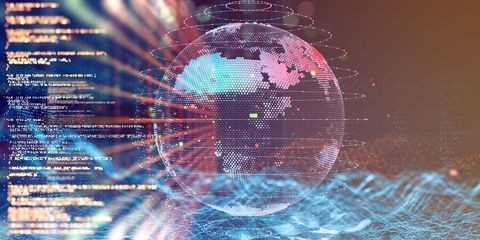Transportation – The March to Digital Mobility
Publication | 02.26.20
[Article PDF]
 It’s not quite The Jetsons, but American streets and airways are starting to look eerily futuristic. Towns are seeing legions of new e-scooters; new-age cars are being introduced with autonomous features; and the skies are alight with drones whose agility and ease of use were unimaginable only a few years ago. Meanwhile, Crowell & Moring’s cutting-edge digital clients are testing unmanned delivery vehicles meant to travel sidewalks, drones of various sizes, smaller and lighter street vehicles, and fully autonomous cars and trucks.
It’s not quite The Jetsons, but American streets and airways are starting to look eerily futuristic. Towns are seeing legions of new e-scooters; new-age cars are being introduced with autonomous features; and the skies are alight with drones whose agility and ease of use were unimaginable only a few years ago. Meanwhile, Crowell & Moring’s cutting-edge digital clients are testing unmanned delivery vehicles meant to travel sidewalks, drones of various sizes, smaller and lighter street vehicles, and fully autonomous cars and trucks.
We live in dynamic times, and previous leaders in mobility have seized commanding market positions by launching first and seeking permission later. After all, what else can they do when law lags behind science? Startups that launch early similarly stand to gain the edge in publicity, funding, and user networks.
But unlike many digital developments, mobility solutions involve real people cruising hazardous streets and airways. Serious accidents can sink a product or a business. Even without mishaps, getting labeled as rogue by regulators and officials can imperil a company’s brand and delay its license to operate in desired markets.
For mobility companies intent on staying on the right side of regulatory agencies, that requires rules—and, when it comes to digital mobility, rules are few and far between.
Rules and Contracts and Disruption, Oh My
Most safety regulations for transportation were written before the move from analog to digital, notes Cheryl Falvey, a partner in Crowell & Moring’s Mass Tort, Product, and Consumer Litigation Group and former general counsel of the Consumer Product Safety Commission. They tend to focus on the products and their components themselves, and not the new-age challenges that can arise when their connected ecosystem fails to operate as intended, such as through hacking or loss of interconnection.
In January 2019, one commissioner at the CPSC released a “framework” for safety for the Internet of Things intended to provide broad-based “technology-neutral best practices to ensure consumer product safety.” By the end of the year, however, the commission had not yet issued binding rules.
Meanwhile, the National Institute of Standards and Technology is hosting an interagency task force that includes representatives of the CPSC and the National Highway Traffic Safety Administration, which is discussing safety and cybersecurity in the Internet of Things. “All government agencies are watching NIST because they keep coming out with more robust and targeted guidance on these topics,” says Falvey. In July 2019, NIST finalized risk management guidance for the Internet of Things. Meanwhile, several states have mandated basic security on internet-connected devices.
“Many emerging technologies are produced outside the U.S., but U.S. manufacturers and importers operating in the U.S. will be responsible for ensuring regulatory compliance,” notes Rebecca Baden Chaney, a partner in Crowell & Moring’s Mass Tort, Product, and Consumer Litigation and Product Risk Management groups.

|
"U.S. manufacturers and importers operating in the U.S. will be responsible for regulatory compliance" of technologies produced outside the U.S. |
Regulation aside, mobility players need their contracts to keep pace. When already-complex devices require connection with many other complex devices, the supply chain gets longer and potential sources of liability mushroom. As a constellation of new software and hardware companies join the mobility supply chain, “contracts have to be entirely rethought,” says Scott Winkelman, a partner in Crowell & Moring’s Mass Tort, Product, and Consumer Litigation Group. Major new suppliers are not traditional auto industry players and lack experience dealing with transportation safety agencies and negotiating terms in the industry. And Big Tech titans moving into mobility bring entirely new levels of leverage to contract negotiations. As if this weren’t complicated enough, trade wars, Brexit, climate change, and other global forces are disrupting transportation supply chains in ways rarely seen before.
One concrete measure of mobility that companies can take now is to embed in their contracts with software suppliers the right to see their source code if needed, says Falvey. If a safety incident might be traceable to defective or hacked software, then an immediate review of that source code may be necessary—and it may be difficult to access that proprietary information without a prior agreement in place.
Autonomous Vehicles: Waiting for WinnersFans of autonomous vehicles have been feeling impatient recently, as some developers conclude that the artificial intelligence needed to handle all the “edge cases” presented by human behavior on the roads isn’t quite ready for prime time. Meanwhile, studies such as a feature in The Economist warn that China might beat the U.S. to widespread deployment of AVs. That’s because Chinese officials are using their overwhelming command-and-control authority to modify transportation infrastructure to be AV-friendly, limit liability for AV companies, and encourage development of 5G technology. As a result, Chinese AVs may soon be roaming the streets in environments custom-built for them—even if those vehicles lack the AI capabilities of American AVs. In an ideal world, U.S. officials would develop a “Marshall Plan for digital” that would design digital-friendly policy in unified fashion around chosen technologies, says Crowell & Moring’s Scott Winkelman. Instead, they’ve opted for what Winkelman calls the next best thing: an approach that is technology-neutral and focused less on means than on (safe) ends. The NHTSA is a sterling example. It has convened stakeholder groupings that have collaborated on a series of autonomous driving guidelines that are “measured, practical, and focused on safe driving and safe vehicles,” Winkelman says. Guidelines released in 2018 declared that the NHTSA would reconsider safety standards to accommodate AV technologies. In 2019, the agency took comments on rules that could allow vehicles without manual controls to operate on public roadways. Federal legislation that would allow for uniform treatment of autonomous vehicles nationwide remained stalled in 2019. If history is any guide, the wait could be long, Winkelman says, unless or until a significant safety incident occurs or a given state gets so far out ahead that the feds feel compelled to act. |
New Roles and Responsibilities
Rentable e-scooters and autonomous drones and vehicles might not seem to have much in common, but they all involve new ownership and distribution models that bring up new challenges—and opportunities—in terms of safety, liability, and the public obligations of vehicle manufacturers.
For example, individual car and truck owners are generally expected to be primarily responsible for maintenance. But today’s rentable vehicles—and many of tomorrow’s autonomous vehicles—are generally owned by the company putting them out on the streets. “Now it is on that owner, not the consumer, to be accountable for safety,” Falvey says. “Officials and regulators are still working out what they expect those companies to do and what their legal authority to require it is.” While the Federal Aviation Administration is clear on these expectations for aircraft, other agencies are still catching up, she adds.
As regulators work these questions, they’re demanding data they can use to make safety-related decisions. Many startups don’t realize they need to collect this data in the first place, Falvey says; in fact, they should be ready to provide it to regulators on short notice, accompanied by the necessary analysis. The data includes how often the vehicles are being used, maintenance schedules, which product issues are being reported, and how quickly the company responds.
Much of this data is also important for companies’ own internal use as they determine how best to keep their vehicles in safe working order, Falvey adds. Companies must understand the lifecycle of their vehicles and their components in real-life commercial use, because unlike the average individually owned car or bike, these items may be used dozens of times a day. They must also be willing and able to put the vehicles in “maintenance mode” so that they can’t be used until they’ve been repaired. “These companies have innovated on the product side. Now they need to innovate throughout the product’s lifecycle, considering the maintenance and support needed out in the field,” Falvey says.

|
"Now companies need to innovate throughout the product's lifecycle, considering the maintenance and support needed out in the field." |
While startups are accustomed to testing products in controlled conditions, they must account for “human factors”—that is, how having actual humans controlling and surrounding these vehicles affects operational safety, says Mary-Caitlin Ray, a counsel in Crowell & Moring’s Aviation Group and a former attorney in the Federal Aviation Administration’s Office of the Chief Counsel. The analysis must consider not only the variability of humans but also how the vehicle affects its environment. How do pedestrians and drivers react to seeing a scooter on the street? How do people on the ground (or pilots in the air) react when they see a drone?
Drones: Delayed Liftoff
While micro-mobility options are proliferating, widespread adoption of autonomous drones appears farther off. The FAA has several rulemakings underway; the most hotly anticipated would develop standards for Remote ID, a technology that would allow unmanned aircraft to operate within a system similar to the air traffic control system now in place for manned aircraft. “This technology is a critical piece in ensuring that drones are safely integrated into the National Airspace System, and it plays both safety and enforcement functions,” Ray says. Electronic “license plates” would allow drones to “see” and communicate with each other and would identify the operator of the drone, providing law enforcement with actionable information in the event of an emergency or a rogue drone.
Though much delayed, the rulemaking process for Remote ID will be underway by early 2020. It will be followed by rulemakings allowing commercial operators to conduct more complex operations without obtaining special permission from the FAA. That would include operations beyond the operator’s line of sight and operations over people—crucial for tasks such as facility inspections as well as for deliveries.
For companies with an eye on commercial package delivery programs, a vast majority of these operations are forced to conform to regulatory requirements developed for manned aircraft, known as a Part 135 certificate. Thus, they must obtain exemptions for a host of requirements such as use of seat belts and on-board operations manuals. These requirements and others have made the Part 135 certificate time- and cost-prohibitive for many operators. For new entrants to the aerospace sector, the challenge will be getting to know the FAA and its “unique language of trust and very specific safety culture,” Ray says. Companies not steeped in the aviation space may find it a difficult language to learn.
Beyond deliveries, drone aficionados are excited about the potential of larger drones to carry heavier cargoes and even people, reducing costs and relieving traffic congestion. But “until there is a clear path to certification specific to drone operators,” Ray jests, “drone-delivered pizza is just a pie in the sky.”
|
"Until there is a clear path to certification specific to drone operators, drone-delivered pizza is just a pie in the sky." |
The Time Is Now
As regulators race to catch up, the savviest mobility companies are taking matters into their own hands. Ensuring access to data, upgrading contracting practices to fit the digital era, maintaining relations of trust with regulators, diagnosing and improving supply chains—all this can be done without a single law enacted. “Digital disruption will have winners and losers,” Winkelman says. “Would-be winners are the ones working to earn it now.”

|
"Digital disruption will have winners and losers. Would-be winners are the ones working to earn it now." |
Insights
Publication | May 25-27, 2008
“ISI mitigation using bit-edge equalization in high-speed backplane data transmission,” in IEEE International Conference on Communications, Circuits and Systems (ICCCAS 2008), pp. 589 - 593.
Publication | 04.18.24
Publication | 04.16.24
Rochester, NY, Diocese's Creditors To Mull Rival Ch. 11 Plans






